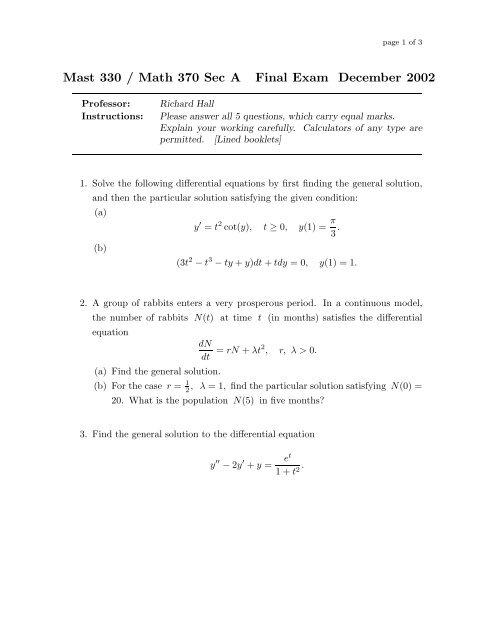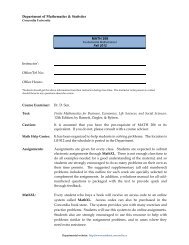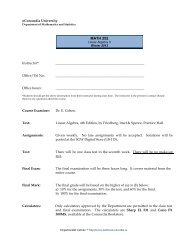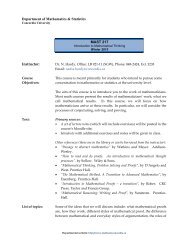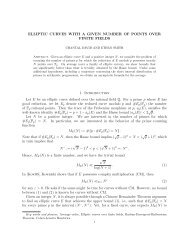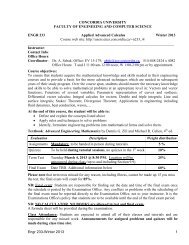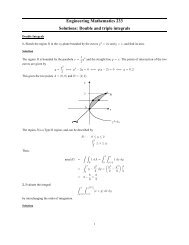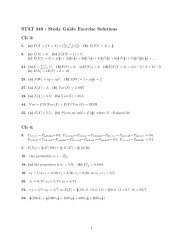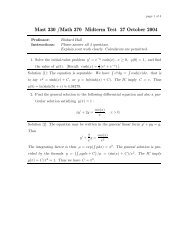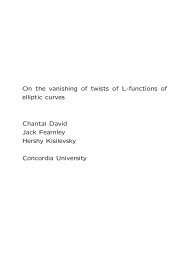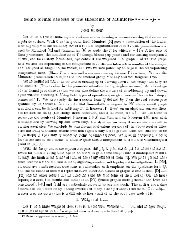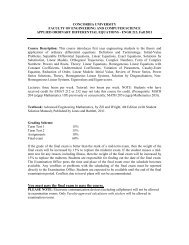Mast 330 / Math 370 Sec A Final Exam December 2002
Mast 330 / Math 370 Sec A Final Exam December 2002
Mast 330 / Math 370 Sec A Final Exam December 2002
You also want an ePaper? Increase the reach of your titles
YUMPU automatically turns print PDFs into web optimized ePapers that Google loves.
page 1 of 3<br />
<strong>Mast</strong> <strong>330</strong> / <strong>Math</strong> <strong>370</strong> <strong>Sec</strong> A <strong>Final</strong> <strong>Exam</strong> <strong>December</strong> <strong>2002</strong><br />
Professor:<br />
Instructions:<br />
Richard Hall<br />
Please answer all 5 questions, which carry equal marks.<br />
Explain your working carefully. Calculators of any type are<br />
permitted. [Lined booklets]<br />
1. Solve the following differential equations by first finding the general solution,<br />
and then the particular solution satisfying the given condition:<br />
(a)<br />
y ′ = t 2 cot(y), t ≥ 0, y(1) = π 3 .<br />
(b)<br />
(3t 2 − t 3 − ty + y)dt + tdy =0, y(1) = 1.<br />
2. A group of rabbits enters a very prosperous period. In a continuous model,<br />
the number of rabbits N(t) at time t (in months) satisfies the differential<br />
equation<br />
dN<br />
dt = rN + λt2 , r, λ > 0.<br />
(a) Find the general solution.<br />
(b) For the case r = 1 2<br />
, λ =1, find the particular solution satisfying N(0) =<br />
20. What is the population N(5) in five months<br />
3. Find the general solution to the differential equation<br />
y ′′ − 2y ′ + y =<br />
et<br />
1+t 2 .
<strong>Mast</strong> <strong>330</strong> / <strong>Math</strong> <strong>370</strong> <strong>Sec</strong> A <strong>Final</strong> <strong>Exam</strong> <strong>December</strong> <strong>2002</strong> page 2 of 3<br />
4. Consider the differential equation representing forced vibrations of a springmass<br />
system with friction, given by<br />
x ′′ + x ′ + 5 4 x = cos(ωt),<br />
where x(t) is the position of the mass at time t, and ω is a positive parameter.<br />
(a) Find the general solution.<br />
(b) Find C(w), the amplitude of the steady-state (large-time) solution.<br />
(c) Sketch C(ω), the ‘resonance curve’, and find for what value ˆω of ω C(ω)<br />
is maximum.<br />
5. By using Laplace transforms or otherwise solve the following initial-value problem<br />
in which a linear system, initially at rest, receives an impulse at t =1:<br />
y ′′ − y =3δ(t − 1), y(0) = y ′ (0) = 0.<br />
Verify that your answer to this problem is indeed a solution to the given differential<br />
equation.
<strong>Mast</strong> <strong>330</strong> / <strong>Math</strong> <strong>370</strong> <strong>Sec</strong> A <strong>Final</strong> <strong>Exam</strong> <strong>December</strong> <strong>2002</strong> page 3 of 3<br />
Table of Laplace Transforms<br />
f(t) =L −1 {F (s)}<br />
1<br />
F (s) =L{f(t)} = ∫ ∞<br />
0 e−st f(t)dt<br />
1<br />
s , s > 0<br />
e at 1<br />
s−a , s>a<br />
t n , n integer > 0<br />
n!<br />
s n+1 , s > 0<br />
t p ,<br />
p > −1<br />
sin(bt)<br />
cos(bt)<br />
Γ(p+1)<br />
,s>0<br />
s p+1<br />
b<br />
s 2 +b 2 , s > 0<br />
s<br />
s 2 +b 2 , s > 0<br />
sinh(bt)<br />
cosh(bt)<br />
e at sin(bt)<br />
e at cos(bt)<br />
e at f(t)<br />
b<br />
s 2 −b 2 , s > |b|<br />
s<br />
s 2 −b 2 , s > |b|<br />
b<br />
(s−a) 2 +b 2 , s>a<br />
s−a<br />
(s−a) 2 +b 2 , s>a<br />
F (s − a), s > a<br />
(−t) n f(t), n integer > 0 F (n) (s)<br />
f (n) (t) s n F (s) − s n−1 f(0) − ...− f (n−1) (0)<br />
f(ct)<br />
u c (t)<br />
1<br />
c F ( )<br />
s<br />
c , c > 0<br />
e −cs<br />
s ,c≥ 0<br />
u c (t)f(t − c) e −cs F (s), c ≥ 0<br />
δ(t − c) e −cs , c ≥ 0<br />
∫ t<br />
0<br />
f(t − τ)g(τ)dτ<br />
F<br />
(s)G(s)


